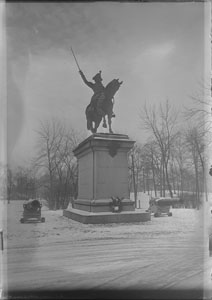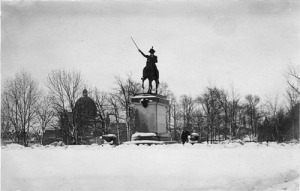The UWM Libraries recently published the video archives of the Milwaukee Gay/Lesbian Cable Network (MGLCN), an important media collection relating to local LGBT history. MGLCN was a volunteer group that produced regular and special programming on gay and lesbian issues for Milwaukee’s public access channel from the mid-1980s to the early 1990s. Its most significant programs were Tri-Cable Tonight and New Tri-Cable. When the first episode of Tri-Cable Tonight aired on October 27, 1987, Milwaukee joined the ranks of only ten other cities in the United States with regular gay/lesbian programming. The 30-minute programs were produced monthly (with a few exceptions), and each show broadcast about three times a month on Warner Cable Channel 14. Programs combined in-studio news presentations, interviews, and discussions with on-location coverage of community events. Regular features included a discussion of homosexuality in history, guest editorials, legal advice, and film reviews. In addition to covering local news, the program covered events of statewide and national significance, such as the National March on Washington D.C. for Lesbian/Gay Rights on October 11, 1987; the Democratic National Convention in 1988; efforts by the Rawhide Boys Ranch to exempt itself from Wisconsin’s civil rights law; and the NAMES Project AIDS Memorial Quilt. The program concluded in December 1989. During its two-year run, Tri-Cable Tonight earned many awards, including first place in the 1989 Hometown USA Video competition, several MATA awards, and the Cream City Business Association’s President’s Award.
The New Tri-Cable consisted of moderated panel discussions on a specific issue. Topics included racism, homophobia, safer sex, serial killer Jeffrey Dahmer, and the AIDS Memorial Quilt. The program lasted from November 1990 through March/April of 1992 and consisted of 28 episodes. Both Tri-Cable Tonight and New Tri-Cable aired during a historical period marked by the AIDS crisis and rising political opposition from the Religious Right.
These programs can now be found online as the Milwaukee Gay/Lesbian Cable Network Programs. Digitization of the collection was supported by an endowment for the Archives and Special Collections established by Joseph R. Pabst and the Greater Milwaukee Foundation’s Johnson and Pabst LGBT Humanity Fund.
-Emma Cobb
A blog dedicated to highlighting the digital holdings of the UW-Milwaukee Libraries
Wednesday, May 21, 2014
Friday, May 16, 2014
The Canons of Kosciuszko Park
The Roman Kwasniewski photograph collection includes many photographs of the Tadeusz Kosciuszko monument at Kosciuszko Park on Milwaukee’s south side. Most of the photographs were taken in the 1920s when the monument was located in its original location on the north side of the park. Those photographs all include two cannons flanking the mounted general. I frequently pass the park these days, and there are no cannons next to the monument anymore. Naturally I thought, “What happened to the cannons?”
While conducting research on a set of parade photographs that were taken around 1937, I found the key to the cannon mystery. Using the Google News database I found a Milwaukee Journal article from April 26, 1976. The article reported on a tribute the Old South Side was having for two of its famous monuments, that of Kosciuszko and another for Casimir Pulaski, two Polish heroes of the American Revolutionary War. The article quoted Kosciusko Park supervisor James Filut, who noted that the heavy cast iron cannons had been disassembled and melted down to supply armaments for the war effort in 1943.
It seems fitting that even as late as World War II, the spirit of Kosciuszko was still fighting for the United States when the cannons were melted.
 |
 |
Subscribe to:
Posts (Atom)